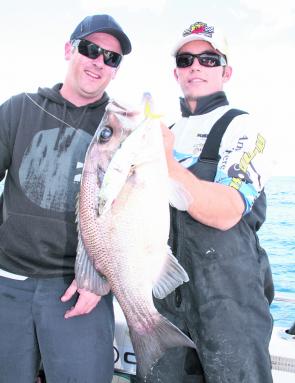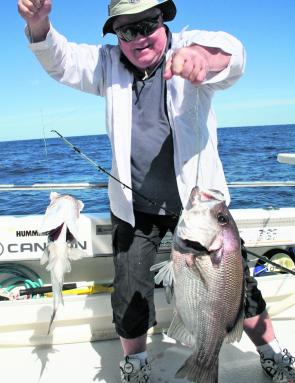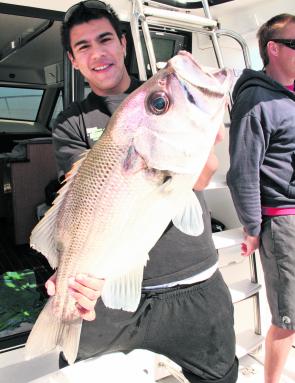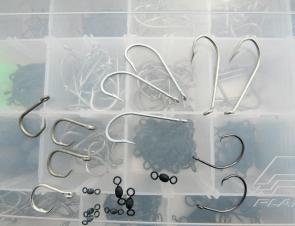We had been sounding up and down the ledge for about 45minutes and I was starting to wonder if the pearlies had not moved further up the coast. I had just about resigned myself to the fact that we may have to move up on top of the reef to look for some snapper when the sounder lit up.
The first time I drove over the school it looked like a small patch of fish but when I turned the boat around and ran over the ledge from another angle, I found the main part of the school.
The waiting had been well worth it. I got the guys on deck ready and spun the big Steber around. There was a fair bit of current running so I would have to slow the drift down by reversing with the motors.
The bottom rigs went over the back and I watched the big sonar screen for signs that the fish were still there. Two live baits were also deployed, just in case the fish wouldn’t respond to the baited rigs.
The life started to mark up just as the first lines were hitting the bottom. The first rod buckled over, then the second, then one of the live baits and finally the forth bottom rig and the last live bait. It was pandemonium.
Some fish were pulling drag and at first I thought I had found a school of kingfish or young amberjack.
Two of the bottom rigs let go and the customers wound up slack lines. The other four rods were still bent and slowly the kicking stopped and the fish started to come up heavy. They had to be pearl perch.
The first one surfaced and was quickly netted followed shortly after by the others, all cracking pearl perch.
The bottom rigs that had let go came up with a single hook bent open and the other hook busted off. They must have had double headers on and there was just too much pressure for them to handle.
High fives and yahoos were going on and I hopped down from the flybridge to take some photos of these exceptional fish.
We made one more pass of the school and once everyone had two fish each, we left them biting and went in search of some snapper.
Pearl perch have to be one of the best table fish that we can catch around Northern NSW and southern Queensland.
The thing is that they can be hard to find at times and catches are often limited to the odd one among other fish.
To specifically target them you need to get away from the favoured and pressured grounds that see a lot of traffic. This will mean getting out of your comfort zone and doing a lot of looking and not too much fishing.
The one plus, though, is that when you do come across them, the action will be thick and fast and the fish will be of a decent size.
A good sounder is paramount to finding grounds that pearl perch frequent.
On our charter boat RU4REEL we run a large Geonav with a 2KW transducer that is worth its weight in gold once we get past about 80m depths.
But we’re also getting some great preliminary results with the latest Humminbird Extreme Depth Series and these look like becoming valuable assets for those who like to head wide.
A standard sounder will still find you fish and we have found plenty of good reef and pearlies with our standard gear, but the big 2KW transducer lets me sound a lot faster and if it isn’t showing anything on the bottom then I know that having a drop will be a waste of time.
Pearl perch often mark up on your sounder a bit off the bottom and although they can get to a reasonable 5kg, they don’t always put out a very strong sounding on your machine.
Some schools that are sparse show up as a slight light green scattering of life. If they are thick and tightly bunched up, though, they mark up in a darker colour and are easier to see.
You do get pearl perch on the hard rock from time to time but they seem to prefer the gravelly shale stuff on the drop-offs or just off the main rock.
Whether this is due to what they eat or what eats them I wouldn’t know but if I am specifically targeting pearlies then I look off the main rocks where they drop down into the deeper water.
A good depth to start looking on the wider reefs off the 50-fathom line is where the main reef drops from around 80m-85m into 100m.
You don’t need a significant edge, either. A school of pearlies can often hold on a 2m drop or ledge and will simply move up and down this edge until they come across food or a comfortable area to hold.
Your standard paternoster bottom-bouncing rig will be fine for pearl perch because they generally hold quite close to the bottom. A 12oz or 16oz snapper lead with two hooks run off droppers just above the weight will be fine.
Ensure, though, that you use quality trace line of around 50lb when making your rig because the bigger pearlies can be quite strong and will sort out your gear, especially if you hook a double-header.
Live bait rigs also work well and we use the same rig that we use for kingfish or amberjack to target the pearl perch. They are often found in similar areas to the AJs so you don’t want to be undergunned when dropping over live bait.
Pearlies are definitely not leader shy when using live bait and you also get the biggest models on the livies.
For the live bait rig, snood two Mustad Big Gun hooks about 10cm-15cm apart, depending on the size of the live bait and pin the front hook through the bait’s nose and the rear hook around the tail area.
This allows your bait to swim head first when you are dropping it to the bottom and it won’t drown. The back hook acts as a stinger and on the larger baits often pins the pearl perch.
Pearlies have big bucket mouths so all you need do is just give them a bit of time to get the bait right down before striking.
We almost always have two live baits going when we are targeting the pearlies because they may be in a shut-down mood and won’t respond to the dead bait on the bottom rigs. The live bait seems to fire them up and once you get a couple on the livies, the bottom rods go off as well.
Anyone who says pearl perch don’t fight hasn’t caught a big one.
They pull hard and we have lost quite a few due to customers pulling too hard on them.
When you get the bite, strike and start to wind immediately once you feel the weight of the fish. If it is a good pearly then let it have its head, it won’t play up for long and once you get them a reasonable distance off the bottom the fight goes out of them and they feel like you are pulling up a bucket.
The key, though, is not to pump and wind.
Even though this goes against what most of us think, the weight of that big snapper lead bouncing up and down when you are lifting and dropping the rod can tear a big hole in the fish’s mouth as it is coming up.
It then takes only a slight bit of slack line for the fish to fall off.
The problem with that is that pearlies very seldom float up due to the effects of barotrauma, but instead swim straight back down to the bottom.
So if you have one fall off it will be gone in an instant.
Try to keep a steady wind happening. If you get tired simply slow down, as long as you keep the fish steadily coming up to the surface.
Once the fish hits the surface, have a net ready and put it under the fish when lifting it on the line into the boat out or, to be certain, simply net the fish.
The hooks you choose for pearlies can also be a big help in landing most of the bites that you get.
We went through several brands and models before finding one that does the job very well. It is a small Mustad circle with a fairly thick shaft.
It surprises many of our customers when we tie them on because they seem too small for the job, but we have found that the smaller circles and J-hooks find a good purchase in the hard, bony corners of the fishes’ mouths, whereas the larger hooks get in past the bone and hook into the softer tissue.
These larger hooks have a tendency to tear a hole a lot easier and thus the potential for the fish to fall off increases.
We generally run a small J-hook on one dropper and a small circle on the other dropper.
We don’t worry about winding when the fish bites but still strike, with conventional hooks, because the little circles don’t seem to mind the rougher treatment.
Pearl perch often school up in a dense patch and you can hit an area very hard in a very short space of time when you find them.
If you intend catching fish in that area again, you will need to manage the fishery. This may not mean simply adhering to bag limits (minimum size 30cm, bag limit 5) but often staying well below your bag limit, depending on how many people are on the boat.
On the charter boat we often take only a few fish out of an area and then leave it for another day. This means that we can return to the area again and again over a period and catch a few fish off it each time.
Obviously this is your choice and what you do is entirely up to you but managing the fishery will often provide you with good areas to fish over many seasons, and let’s face it, its hard to beat a good feed of pearlies.
Reads: 3103
Pearl perch love live bait and quite often a livie tempts the bigger fish.

Jigging with fast or slow metal also accounts for its fair share of pearl perch.

If you find a school of pearlies then double headers can be common. Just remember the bag limit of five per person.

Amberjack often frequent the same grounds as the pearl perch so be ready for some ‘pearlies’ that pull like tractors. Live-bait rigs should be stronger for this reason.

Pearl perch of this calibre can take a fair bit of time and effort to find. It makes sense to fish wisely and conserve them for future sessions.

When you come across a sounder showing like this you can be pretty confident that you have hit paydirt.

A selection of hooks for pearl perch with live bait and dead. The author generally runs a small J-hook on one dropper and a small circle on the other. Smaller hooks bed in the jaw, while bigger hooks wear a hole in the soft tissue behind the jaw and can w




